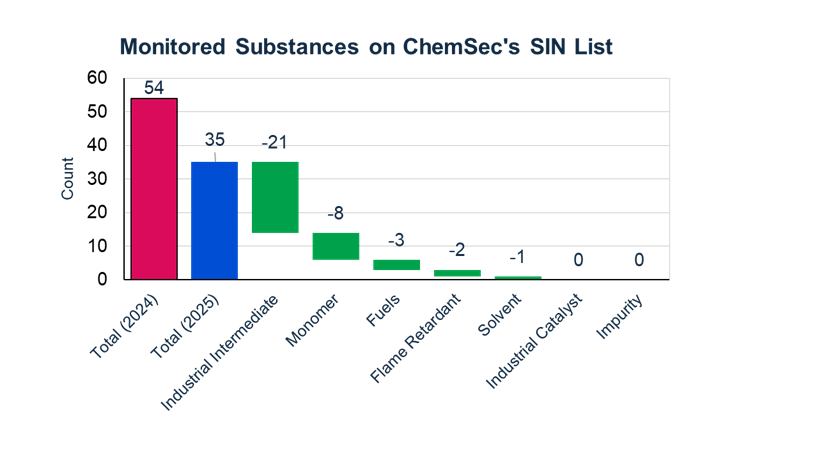LYB operates in over 90 manufacturing sites in 32 countries. All sites follow our Global Product Stewardship Standard and no site manufactures products that contain substances whose use is prohibited or exceeds applicable restriction limits in the United States (US) or European Union (EU), even where local law or rules may allow such products to be made.
As a Responsible Care® Company, we are committed to promoting a comprehensive approach to chemicals management and sustainability in all aspects of our products’ life cycles, including design, manufacturing, distribution, use, recycling and disposal activities. We apply the same product safety standards for all LYB products, including products based on recycled raw materials. Our testing protocols go beyond regulatory requirements and are used globally for all LYB products to assess their use and suitability in all applications. Our commitment is outlined in our Responsible Chemicals Management Position.
LYB endeavors to remove Substances of Very High Concern (SVHC)1 from products that may be used in sensitive end use applications beyond market requirements and global regulations or reduce them to less than 0.1 wt% where reasonably possible. As part of our Global Product Stewardship Standard, our global product portfolio assessment helps us continually advance safer solutions by reviewing products for the presence of SVHC, prioritizing SVHC for further analysis, evaluating alternatives, and substituting, eliminating or reducing SVHC presence in products where feasible. In addition, we implement safety and sustainability criteria as part of our product innovation process.
We have additional well-defined testing protocols to rigorously test post-consumer recycled raw materials as well as our finished products containing recycled content prior to permitting their use in an end-use application. This testing includes full composition analysis and non-intentionally added substances (NIAS) screening. Where information does not support the use of recycled materials, they are prohibited or restricted under our policies or standards. This restriction is cleared only after a thorough risk assessment process which includes testing, validation for hazardous substances (such as SVHC above 0.1 wt%) and ensuring sound governance through good manufacturing practices in our facilities.
Through our global product portfolio assessments, we have succeeded in reducing the presence of SVHCs in products. For example, our Intermediates and Derivatives Business identified one product, glycol ether PM, with a technically unavoidable isomeric impurity classified as a category 1B reproductive toxicant. After a thorough review of the analytical data over a multiyear period and working together with the two manufacturing sites that produce this product, we were able to reduce the specification of the isomeric impurity from 0.3% to below 0.1%. As another example, while LYB does not manufacture PFAS, we’ve been working to address intentionally added PFAS in our product portfolio since 2022. We’ve identified solutions for the majority of volumes with intentionally added PFAS. As viable alternatives are established for safety-sensitive applications and customers accept reformulated products, our desire is to eliminate intentionally added PFAS from our product offering while maintaining the highest standards of quality and performance.
Use of SVHC
In 2024, less than 2% of our revenue was generated from products containing substances that are listed in REACH Annex XVII in compliance with the applicable conditions.
In 2024, less than 0.1% of our total number of products (representing approximately 3% of revenue), contained substances in the candidate list of SVHC for authorization above 0.1wt%. Further, we note that these products were placed on the market almost exclusively (>99.9% by revenue) for monomer or intermediate uses. In such industrial use settings, involving suitably qualified and trained individuals, exposure risk and use is rigorously controlled, for example via technical means and appropriate personal protective equipment as part of the operator's health and safety compliance obligations.
SVHCs are identified based on problematic characteristics, including persistence in the environment. In 2024, less than 2% of our revenue was from products containing persistent substances.2 LYB does not produce PFAS compounds. LYB is working to eliminate intentionally added PFAS from our products, which will drive revenues from products containing persistent substances down to < 0.2 % of total revenue.
1Defined in Article 57 of Regulation (EC) No 1907/2006 (REACH). SVHCs are chemical substances that may have serious effects on human health or the environment. These include substances that are: Carcinogenic, Mutagenic, or Toxic for Reproduction (CMR), Persistent, Bioaccumulative, and Toxic (PBT), Very Persistent and Very Bioaccumulative (vPvB) or identified as causing an equivalent level of concern (e.g., endocrine disruptors)
2Substances which are persistent, bioaccumulative and toxic (PBT) or very persistent and very bioaccumulative (vPvB) according to REACH Annex XIII; or substances which are very persistent and very mobile (vPvM) according to the EU Classification, Labelling and Packaging Regulation.
Products containing certain substances on ChemSec’s SIN list
The International Chemical Secretariat (ChemSec) is an independent non-profit organization that advocates for safer alternatives to hazardous chemicals through its Substitute It Now (SIN) list. As of September 2025, the LYB product portfolio contains 35 substances on the SIN List. However, the vast majority of products with these substances are used as monomers and / or intermediates in industrial settings, meaning there is very limited consumer exposure. A detailed view of the uses of ChemSec’ s SIN-list substances can be found below:

LYB strives to provide transparency with the hazard classification and categorization of substances in our product portfolio, including substances in products for 'intermediate use only’ and/or ‘monomer use only'.
